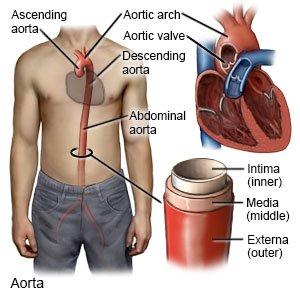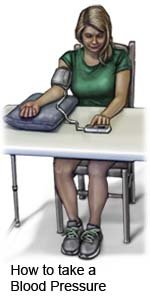Ascending Thoracic Aortic Aneurysm
Medically reviewed by Drugs.com. Last updated on Aug 4, 2025.
What is an ascending thoracic aortic aneurysm (ATAA)?
An ATAA is a bulge in the part of the aorta closest to your heart. The aorta is a large blood vessel that goes from your heart down into your abdomen. ATAA can occur if the aorta or its valve is damaged, inflamed, or not formed correctly. An ATAA may continue to grow and rupture (burst), or it may dissect (tear) suddenly. An ATAA that bursts or tears is a life-threatening emergency.
 |
What increases my risk for an ATAA?
- Being male or age 60 or older
- Nicotine use
- High blood pressure (BP)
- A genetic condition that affects your heart, aorta, or aortic valve
- A connective tissue disorder such as Marfan syndrome or vascular Ehlers-Danlos syndrome
- A family history of an ATAA or thoracic aortic aneurysm (TAA)
- Inflammation of your aorta
What are the signs and symptoms of an ATAA?
You may have no signs or symptoms. You may have any of the following if your ATAA grows, bursts, or tears:
- Pain in your chest, back, neck, or jaw
- Hoarseness, a cough, or trouble swallowing
- Trouble breathing or shortness of breath
- Coughing or vomiting blood
- Being able to see your neck veins move or pulse
- A heart murmur (whooshing sound)
- Weak pulses in your arms
How is an ATAA diagnosed?
An ATAA may be diagnosed when you have a test done for another condition. Your healthcare provider will examine you and ask about your medical history. Tell your provider if you have any symptoms and when they started. Tell your provider about any medicines you take. You may need any of the following:
- An x-ray, CT, or MRI may show the ATAA or a condition causing your ATAA. You may be given contrast liquid before the scan. Tell the healthcare provider if you have ever had an allergic reaction to contrast liquid. The MRI machine contains a powerful magnet. Do not enter the MRI room with anything metal. Metal can cause serious injury from the magnet. Tell the healthcare provider if you have any metal in or on your body.
- An echocardiogram (echo) uses sound waves to show pictures on a monitor. It is used to check your aorta for an ATAA. It may also show how well blood flows through your heart and how well your heart is pumping.
How is an ATAA treated?
- Heart medicines may be given to lower your BP or control how fast your heart beats. This helps prevent your ATAA from growing, tearing, or bursting.
- Cholesterol medicine lowers your cholesterol level to help prevent atherosclerosis (hard or stiff arteries).
- Surgery may be needed to repair your aorta or remove an aneurysm. You may instead need surgery to replace part of your aorta. Your aortic valve may also be replaced if it is not working properly.
How can I manage an ATAA?
- Manage other health conditions to help prevent your ATAA from growing or bursting. Examples are high cholesterol, high BP, and diabetes. Take medicine as directed and follow your treatment plan. Check your BP as directed if you have high BP. Your provider will show you how to do this. Check your BP 2 times, 1 minute apart. Check as often as directed each day. Keep a record of your readings and bring it to your follow-up visits.

- Follow the meal plan set by your provider. Talk to your provider or dietitian about a heart-healthy or low-sodium meal plan. Heart-healthy meal plans are low in sodium, processed sugar, and some fats. They are high in potassium, calcium, heart-healthy fats, and fiber. These can be found in vegetables, fruit, and whole-grain foods. A meal plan can help you lower your cholesterol and BP levels.

- Follow physical activity instructions. Your physical activity plan may include low-intensity activity, such as walking, yoga, or swimming. Regular physical activity can help decrease your BP and cholesterol levels. You may need to avoid intense physical activity, such as weightlifting or running. Intense activity may raise your BP or put pressure on your aorta. These increase your risk for a tear or rupture. You may also need to avoid contact sports such as football to decrease your risk for a chest injury.

- Limit or do not drink alcohol. Alcohol can increase your BP. Ask your provider if it is okay for you to drink any alcohol. Your provider can help you set limits for the number of drinks you have in 24 hours and within 1 week. A drink of alcohol is 12 ounces of beer, 5 ounces of wine, or 1½ ounces of liquor.
- Do not smoke. Nicotine and other chemicals in cigarettes and cigars can increase the risk for your ATAA to tear or burst. Ask your healthcare provider for information if you currently smoke and need help to quit. E-cigarettes or smokeless tobacco still contain nicotine. Talk to your healthcare provider before you use these products. Avoid secondhand smoke when possible.
- Get vaccines as directed. Some viruses can worsen an ATAA. Get a flu vaccine as soon as recommended each year, usually in September or October. Get all recommended COVID-19 vaccine doses and boosters. A pneumonia vaccine may also be recommended. Your provider will tell you if you need other vaccines, and when to get them.
Call your local emergency number (911 in the US) or have someone call if:
- You have any of the following signs of a heart attack:
- Squeezing, pressure, or pain in your chest
- You may also have any of the following:
- Discomfort or pain in your back, neck, jaw, stomach, or arm
- Shortness of breath
- Nausea or vomiting
- Lightheadedness or a sudden cold sweat
- You have any of the following signs of a stroke:
- Numbness or drooping on one side of your face
- Weakness in an arm or leg
- Confusion or difficulty speaking
- Dizziness, a severe headache, or vision loss
- You cough or vomit blood.
- You have trouble breathing or shortness of breath.
- You have sudden chest, neck, back, or abdominal pain.
- You feel dizzy, faint, or you lose consciousness.
When should I seek immediate care?
- You have new or worsening symptoms.
When should I call my doctor?
- You have questions or concerns about your condition or care.
Care Agreement
You have the right to help plan your care. Learn about your health condition and how it may be treated. Discuss treatment options with your healthcare providers to decide what care you want to receive. You always have the right to refuse treatment. The above information is an educational aid only. It is not intended as medical advice for individual conditions or treatments. Talk to your doctor, nurse or pharmacist before following any medical regimen to see if it is safe and effective for you.© Copyright Merative 2025 Information is for End User's use only and may not be sold, redistributed or otherwise used for commercial purposes.
Further information
Always consult your healthcare provider to ensure the information displayed on this page applies to your personal circumstances.
